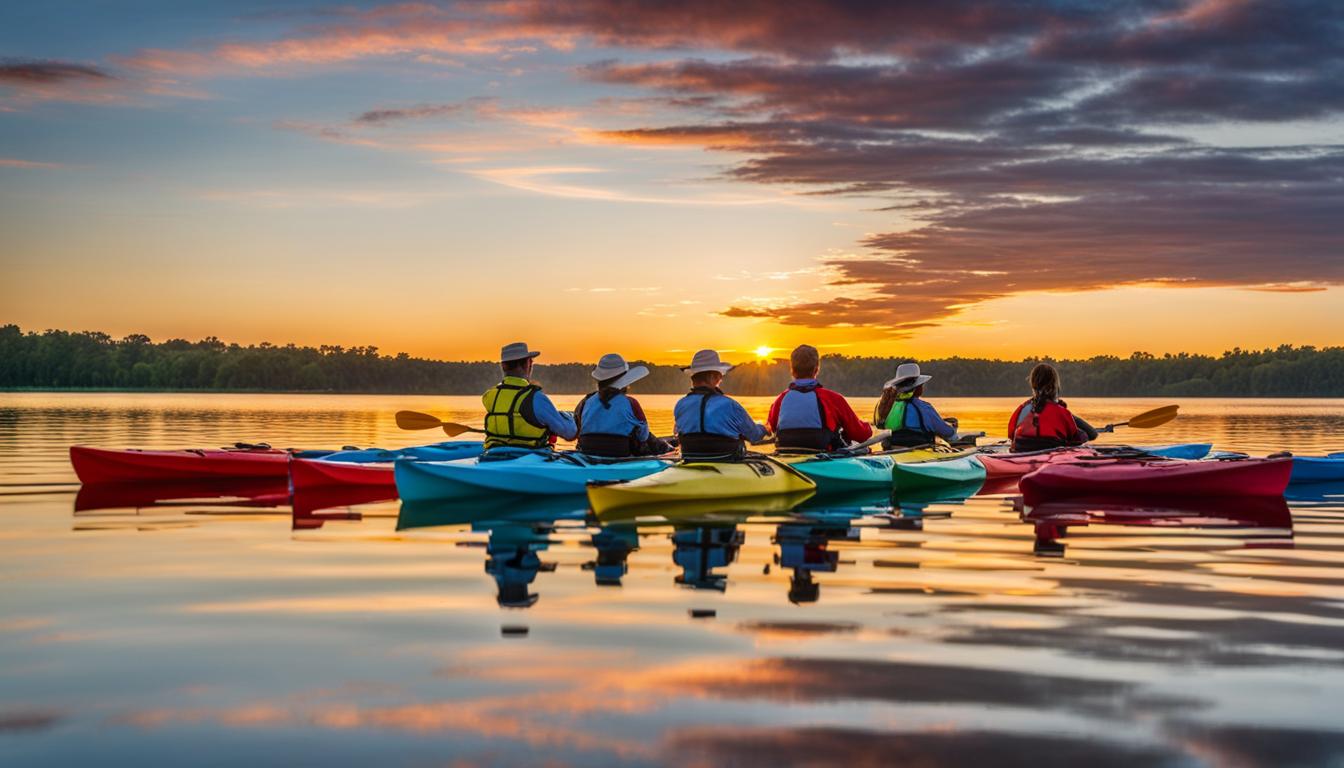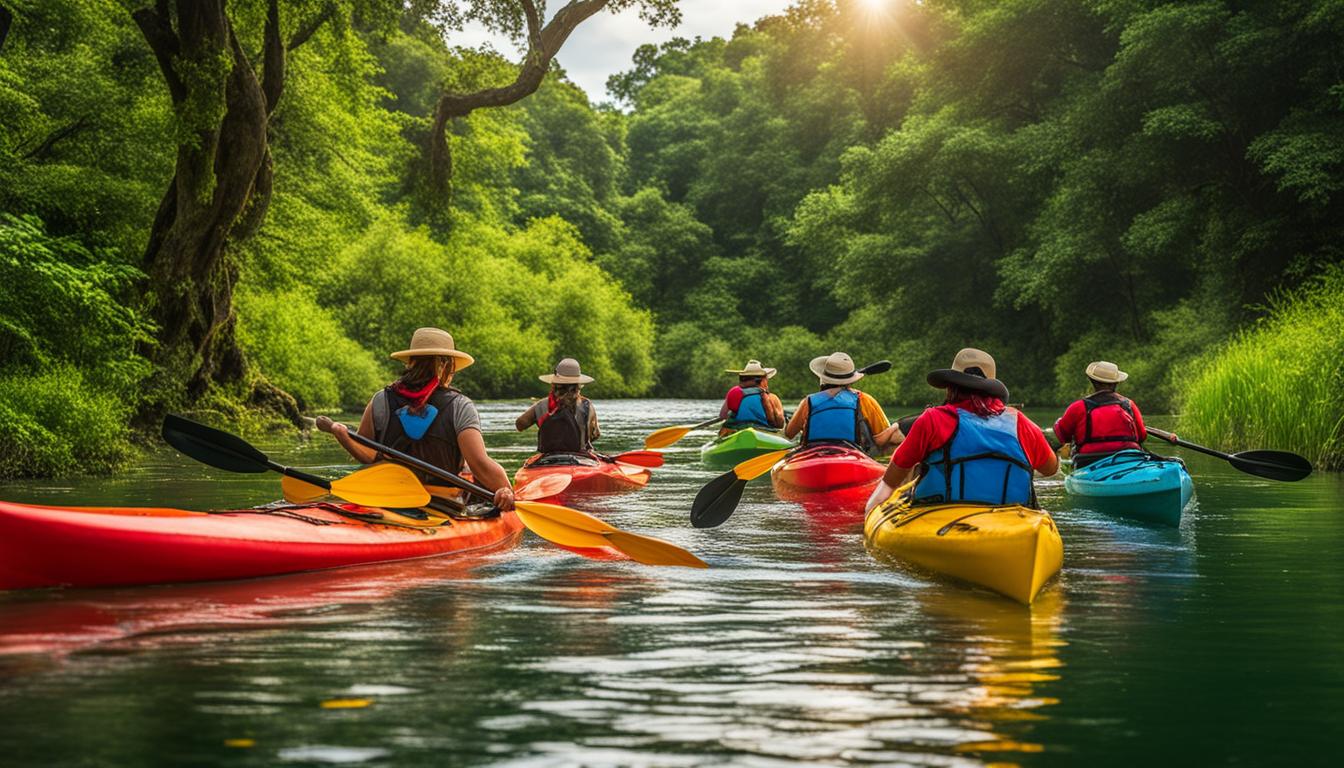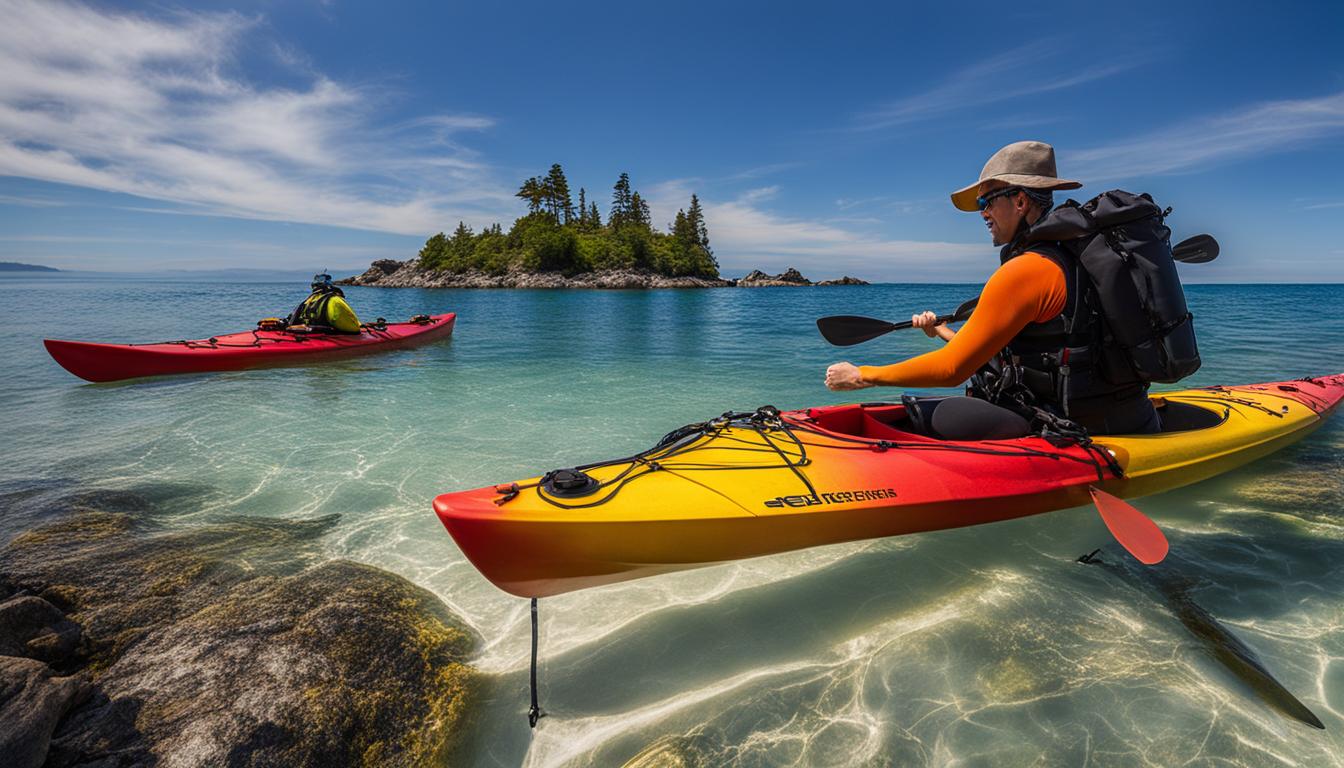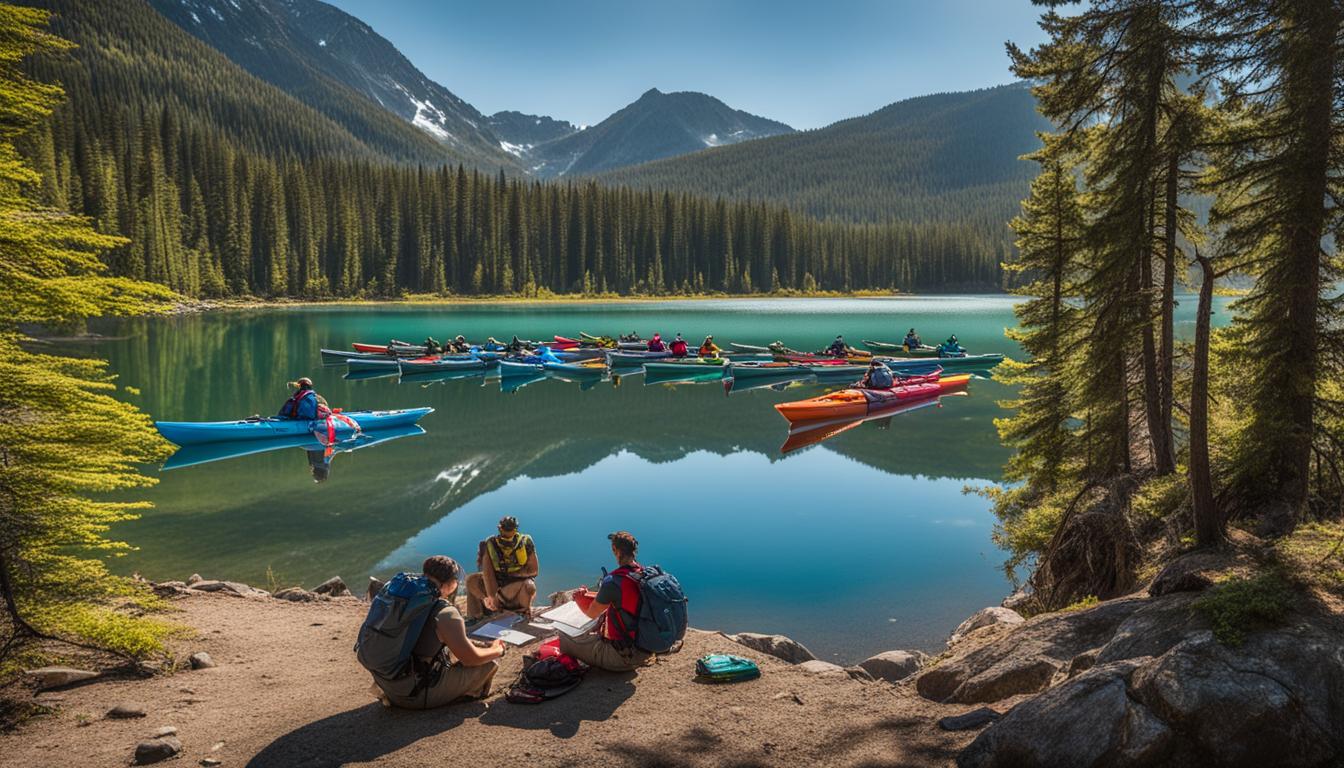Planning a remote kayak camping trip can be an exciting adventure, but it’s essential to prioritize safety. This article will provide you with valuable tips and advice to ensure a secure and enjoyable experience. From packing the right gear to understanding emergency procedures, these safety tips will help you navigate the challenges of remote kayak camping.
Key Takeaways:
- Stay safe while kayak camping by following these important tips.
- Pack the right gear for the weather and water conditions.
- Know what to do in case of a capsize and how to prevent it.
- Choose a route that matches your skill level for a safe trip.
- Take precautions to secure your kayak and gear from theft.
Packing for the Weather and Water Conditions
When embarking on a remote kayak camping trip, it’s crucial to pack according to the weather and water conditions you’ll be facing. Proper preparation will ensure your safety and enhance your overall experience. Here’s a checklist to help you pack the right gear:
- Baselayers: These moisture-wicking garments will keep you warm and dry, even if you get wet.
- Pants: Opt for quick-drying pants that provide protection against sun exposure and potential scrapes or bites.
- Puffy jacket: A lightweight, insulated jacket will provide warmth during chilly evenings.
- Raincoat: Stay dry by packing a waterproof and breathable raincoat.
- Emergency dry clothes: Pack an extra set of dry clothes in case you get soaked.
- Warm synthetic sleeping bag: Ensure a comfortable night’s sleep by choosing a sleeping bag appropriate for the expected temperatures.
It’s important to follow a kayak camping safety checklist to ensure you have all the necessary equipment. This includes:
- PFD (Personal Flotation Device): Always wear a properly fitting PFD while kayaking.
- First aid kit: Be prepared for minor injuries by packing a comprehensive first aid kit.
- Signaling devices: Carry a whistle and a waterproof flashlight for signaling purposes.
By packing thoughtfully and having the right gear, you’ll be well-prepared to handle different weather conditions and water challenges that may arise during your remote kayak camping trip.
| Essential Gear | Recommended Quantity |
|---|---|
| PFD (Personal Flotation Device) | 1 per person |
| First aid kit | 1 per group |
| Whistle | 1 per person |
| Waterproof flashlight | 1 per person |
Knowing What to Do in Case of a Capsize
While kayaking, there’s always a risk of capsizing. Being prepared and knowing what to do in the event of a capsize is crucial for your safety. Familiarize yourself with emergency procedures, such as reentering your kayak and practicing assisted and unassisted rescues. It’s also important to understand the risks of hypothermia and dress appropriately for the water temperature. Additionally, always wear your life jacket to ensure your safety while kayaking.
When a capsize occurs, staying calm is key. Remember to keep your body close to the kayak to conserve body heat and prevent further capsizing. If you are unable to reenter the kayak, it’s important to signal for help and stay with your kayak until rescue arrives. Use a whistle or other signaling devices to attract attention.
Solo kayak camping safety is particularly important when it comes to capsizing, as there may not be anyone else nearby to assist you. Before embarking on a solo kayak camping trip, ensure that you have practiced self-rescue techniques and are confident in your ability to handle a capsize situation on your own.
| Emergency Procedures for Kayak Camping | Solo Kayak Camping Safety |
|---|---|
| Reentering your kayak | Practicing self-rescue techniques |
| Assisted and unassisted rescues | Confidence in handling capsize situations |
| Risks of hypothermia | |
| Importance of wearing a life jacket |
Choosing an Appropriate Route for Your Skill Level
When embarking on a remote kayak camping trip, it’s crucial to choose a route that aligns with your skill level. This ensures a safe and enjoyable experience in the wilderness. Before setting off, take the time to research the area thoroughly. Consider factors such as weather patterns, tidal currents, access to fresh water, and possible bailout points along the route.
By understanding the terrain and potential challenges, you can plan accordingly and make informed decisions about your journey. It’s advisable to start with shorter trips in less challenging waters if you’re a beginner or relatively new to remote kayak camping. As you gain experience and confidence, gradually progress to more demanding routes.
Remember, safety should always be the top priority. It’s better to choose a route that might be less scenic but within your comfort and skill level rather than risking your safety in unfamiliar and hazardous conditions. By selecting an appropriate route, you’ll be able to fully enjoy the beauty of nature while maintaining peace of mind.
Table: Factors to Consider When Choosing a Route
| Factors | Description |
|---|---|
| Weather Patterns | Research typical weather conditions in the area to avoid unexpected storms or extreme conditions. |
| Tidal Currents | Understand the tidal patterns and currents, especially if you’re planning to paddle in coastal areas. |
| Access to Fresh Water | Ensure that there are reliable sources of fresh water along your route for drinking and cooking. |
| Bailout Points | Identify potential bailout points or emergency exit options in case of unforeseen circumstances. |
By considering these factors and evaluating your own capabilities, you can choose a route that offers both adventure and safety during your remote kayak camping trip.
Preventing Theft and Ensuring Equipment Safety
When embarking on a remote kayak camping trip, it’s important to take precautions to prevent theft and ensure the safety of your kayak and gear. By following these tips, you can minimize the risk of theft and keep your equipment secure.
Kayak Security
Securing your kayak is essential to deter theft. Consider using locks or security cables to secure your kayak to a sturdy object, such as a tree or kayak rack. This will make it more challenging for potential thieves to snatch your kayak and make a quick escape. Additionally, avoid leaving your kayak unattended for extended periods, especially in high-traffic areas.
Gear Protection
Protecting your valuable gear is just as important as securing your kayak. Storing your gear in dry bags not only keeps them dry but also adds an extra layer of security. Place your gear in inconspicuous bags or containers to minimize the chances of drawing attention from potential thieves. It’s also wise to keep your gear hidden when not in use, whether that means stowing it in your tent or locking it inside your vehicle.
Personal Safety
While preventing theft is crucial, your personal safety should always be the top priority. When camping in remote areas, be aware of your surroundings and trust your instincts. If you encounter any suspicious individuals, consider relocating to a safer location or notifying local authorities if necessary. Traveling with a group can also enhance your safety, as there is strength in numbers.
By taking these preventive measures, you can minimize the risk of theft and ensure your equipment remains safe throughout your remote kayak camping trip. Remember, prioritizing personal safety and protecting your gear will allow you to fully enjoy the adventure without unnecessary worry.
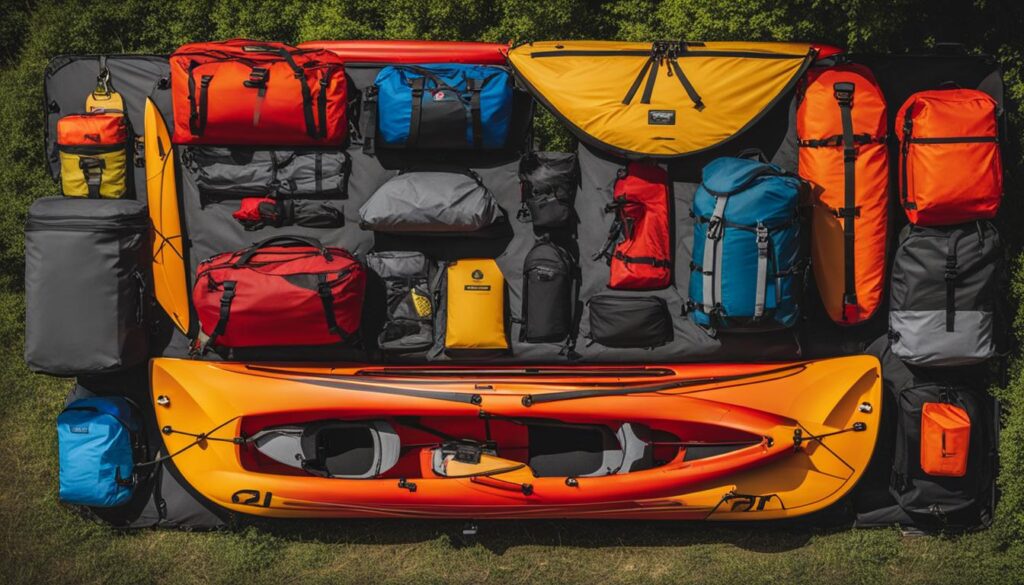
Practicing Situational Awareness and Taking Necessary Safety Measures
To ensure your safety while on the water during a remote kayak camping trip, it’s crucial to practice situational awareness and take necessary safety measures. By staying aware of your surroundings and being prepared, you can minimize risks and enjoy a safe and enjoyable experience.
Stay Aware of Your Surroundings
When kayaking in remote areas, it’s important to be aware of potential hazards and changing weather conditions. Keep an eye on the sky for any signs of approaching storms and monitor changes in wind direction or speed. Waves and currents can also pose risks, so pay attention to the water conditions and adjust your course accordingly. By staying vigilant and proactive, you can avoid dangerous situations and stay safe.
Wear Appropriate Protective Gear
Protecting yourself from the elements is essential when embarking on a remote kayak camping trip. Wear a brimmed hat to shield yourself from the sun, apply sunscreen to exposed skin, and dress in lightweight, quick-drying clothing. A windbreaker can provide extra protection against chilly winds, while proper footwear, such as water shoes or sandals with good traction, will ensure secure footing. Stay comfortable and protected throughout your journey.
Carry Safety Equipment
Always carry essential safety equipment to handle any unforeseen situations while kayaking. This includes a well-fitted life jacket that is U.S. Coast Guard-approved, a bilge pump to remove excess water from your kayak, a whistle to signal for help, and a throw rope for rescue purposes. Remember to secure these items within reach and be familiar with their usage. Being equipped with the right tools can make a significant difference in your safety and the safety of others.
| Safety Measures | Importance |
|---|---|
| Stay aware of your surroundings | Minimizes risks and helps avoid dangerous situations |
| Wear appropriate protective gear | Protects against the elements and ensures comfort |
| Carry essential safety equipment | Enables you to handle unforeseen situations and ensures rescue readiness |
By practicing situational awareness and taking necessary safety measures, you can enjoy the beauty of remote kayak camping while prioritizing your well-being. Remember to plan ahead, stay prepared, and be proactive in ensuring your safety on the water. With these precautions in mind, you can have a memorable and incident-free adventure.

Recap and Importance of Remote Kayak Camping Safety
Safety should be your top priority when embarking on a remote kayak camping trip. By following these essential safety tips, you can ensure a secure and enjoyable experience.
First and foremost, make sure to pack the right gear. This includes essential kayak camping safety gear such as a personal flotation device (PFD), a first aid kit, and signaling devices. These items can be lifesavers in emergency situations.
Additionally, it’s crucial to be prepared for any weather and water conditions you may encounter. Dress appropriately, bring emergency dry clothes, and have a warm synthetic sleeping bag to stay comfortable and ready for unexpected situations.
Remember, remote kayak camping can be a thrilling adventure, but it’s important to practice situational awareness and take necessary safety measures. Be aware of your surroundings, choose an appropriate route for your skill level, and store your gear securely to prevent theft.
By prioritizing your safety and following these tips, you can fully enjoy the wonders of remote kayak camping while ensuring a secure and memorable experience.
FAQ
What should I pack for a remote kayak camping trip?
When preparing for a remote kayak camping trip, it’s crucial to pack according to the weather and water conditions. This includes wearing appropriate clothing and gear, such as baselayers, pants, a puffy jacket, and raincoat. It’s also important to have emergency dry clothes and a warm synthetic sleeping bag. Make sure to follow a kayak camping safety checklist and bring necessary equipment like a PFD, first aid kit, and signaling devices.
What should I do in case of a capsize while kayaking?
Being prepared and knowing what to do in the event of a capsize is crucial for your safety. Familiarize yourself with emergency procedures, such as reentering your kayak and practicing assisted and unassisted rescues. Dress appropriately for the water temperature and understand the risks of hypothermia. Always wear your life jacket to ensure your safety while kayaking.
How do I choose a suitable route for my remote kayak camping trip?
Planning a safe route is essential when embarking on a remote kayak camping trip. Research the area and consider factors such as weather patterns, tidal currents, access to fresh water, and possible bailout points. Choose a route that aligns with your skill level and allows for a comfortable and enjoyable experience. It’s advisable to start with shorter trips before venturing into more challenging waters.
How can I prevent theft and ensure the safety of my kayak and gear while camping in remote areas?
When camping in remote areas, it’s important to take precautions to prevent theft and ensure the safety of your kayak and gear. Consider using locks or security cables to secure your kayak to a sturdy object, such as a tree. Store your valuable gear in dry bags and keep them hidden to deter potential thieves. Always stay vigilant and prioritize personal safety while on your kayak camping trip.
How can I practice situational awareness and take necessary safety measures while on the water?
To ensure your safety while on the water, it’s crucial to practice situational awareness and take necessary safety measures. Stay aware of your surroundings, including weather conditions and potential hazards. Wear appropriate protective gear, such as a brimmed hat, sunscreen, and windbreakers. Consider using a spray skirt to protect yourself from spray and waves. Always carry safety equipment, including a life jacket, bilge pump, whistle, and a throw rope.


